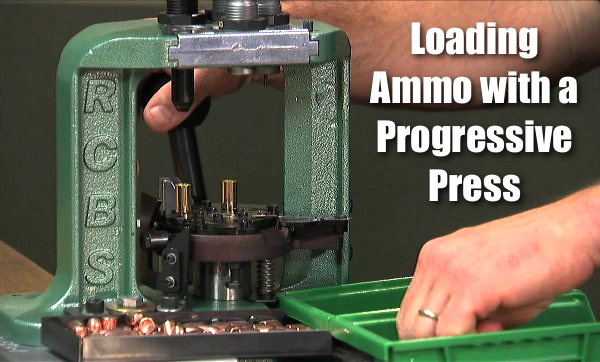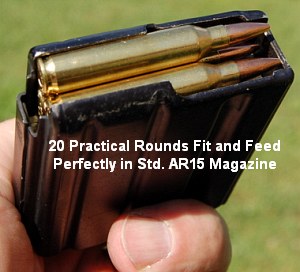The U.S. Army Marksmanship Unit publishes “how-to’ articles on reloading on its Facebook page. One excellent article, part 5 in a 6-part set, focused on Progressive Presses. This article explains the proper procedures for Auto-Indexing Progressives that advance the shell-plate at every pull of a handle. Auto Progressives are efficient, but require special attention because so much is happening at once. You must train yourself to pay attention to every station. This article is a must-read if you are running a progressive press or considering one. Visit the USAMU’s Facebook page for more handloading advice. Progressive Loading Presses – Self-Advancing Type Photo courtesy UltimateReloader.com. Recently, we discussed manually-operated progressive presss for beginning handloaders. This type of press requires that the shellplate be manually advanced after each handle stroke. Beginners will find it easier to use this type of press because nothing happens until the loader commands it. This allows users to avoid problems caused by clearing malfunctions before noticing that the shellplate had advanced itself. (Read the Previous USAMU article on Manual Progressives. The next, more luxuriant type of progressive press advances shellplates automatically when the handle is cycled. [Editor: It is also known as an “Auto-Indexing Progressive Press.] Each stroke is usually designed to automatically prime and size a case and operate the powder measure if it’s used. It also seats a bullet. Some have case feeders which automatically place a new shellplate in each cycle. Some loaders require the loader insert a new case every cycle. In both cases, the loader will usually place a bullet in each case that has been sized/primed/charged. [CAVEAT – While our Handloading Shop is equipped with several progressive presses for powder charges, we throw/weigh ALL of them by hand. Our presses do not have powder measures. Our progressives are only used for brass preparation and priming. They are not designed for full-progressive loading. The manually-advanced presses can be a blessing for beginners, but depending on your style, they can become a mixed blessing as you gain experience. Manual presses are reliable and allow for full scrutiny of each round while being loaded if you pay attention to all operations and load without distractions. Manual progressives can be a liability if you are easily distracted or unable to pay attention. It is easy to forget a powder charge and end up with a squib. [Editor: Using a lock-out die will reduce the chance of a squib charge or double-charge. [See below.] The automatically-advancing progressives help prevent this by ensuring a powder charge will be dropped each time the handle is operated. This feature is often appreciated by experienced handloaders due to its time and effort savings. The two styles of press are determined by a variety of factors. These factors include the ease with which one can change calibers, the number of rounds loaded annually, and how often one must convert dies and shellplates. Automatic progressives, and the caliber conversion kits they come with, are usually more expensive than manual progressions and caliber converters from the same manufacturer. One USAMU handloader who prefers simple, bulletproof machines, and maximum efficiency in converting presses owns two manually advanced progressives. One is set up to handle large primers and the other small primers. He can change calibers with the blink of an eye. This fits his style as he loads many different calibers. Another handloader is doing the opposite. He loads in large quantities, but for a few calibers. His self-advancing press and case-feeder is his favorite because of its speed. To improve efficiency, he makes large quantities of ammo before switching calibers. He uses fewer caliber conversion kits, which are more expensive, than the ones for the manually-advanced progressiv. It is important to choose a manufacturer who has a proven track record of quality, durability, and customer service. Avoid buying the “latest and greatest” model before it has been proven. This writer, for example, knows a loader that received a brand new, expensive, self advancing model press a few years ago, shortly after it was introduced. It is all too common that manufacturers release products before they have worked out any “bugs”. Better safe than sorry — The RCBS Lock-Out die
RCBS makes a “Lock Out Die” that detects the powder charge. This will stop the Progressive press in case you have a double or undercharge. Your Editor has a Lock-Out die on his RCBS Pro 2000. Over the years, it has “saved” his bacon a half dozen times. It can be used with Dillon and Hornady machines as well as RCBS. It did not seat primers at the correct depth. It would not be possible to achieve a better result by adjusting, using extra force or fiddling than to have primers barely flush against the case head. A slightly “high” priming could result from any inattention, with the primer protruding over the case head. It was a danger for slam fires, especially in semi-autos that did not have spring-retracted firing points, like the M1 and M1A. In desperation he had his machinist friend study the problem and machining a new part to fix it. No dice. Even with extended parts, its engineering did not allow for full primer seating. He wishes he had listened to his shooting buddies who told him to stick with a “tried and tested” reliable performer. If you choose a particular press, check to see if it comes with a kit of parts that are commonly replaced. Having springs, pins and other parts on hand can save the day when you are busy loading for a match! In the rare event one breaks or “goes AWOL”, having the necessary springs, pins, etc. on hand can save the day while you are busy loading for a match. Plan your handloading according to primer size. This will improve the efficiency of your loading (rounds loaded in minimal time for set-up and tear-down). If your machine is set up to use small primes, you should load all the calibers you plan to load that require small primers before changing the press to load larger-primer calibers. In the next chapter, we will discuss the peculiarities of progressive-loading for rifle cartridges. We will also provide solutions to problems such as excessive cartridge case headspace variation, tips on how to ensure best powder charge consistency and more. Be safe and have a great shooting experience until then!

















